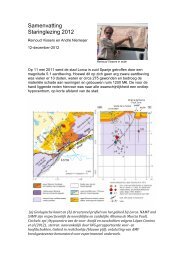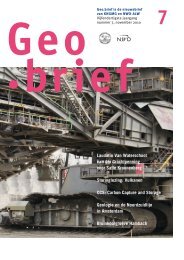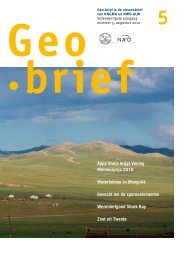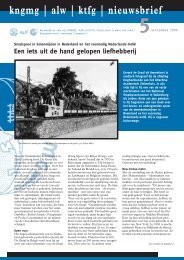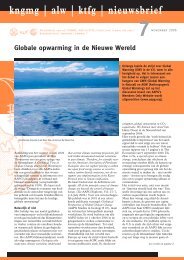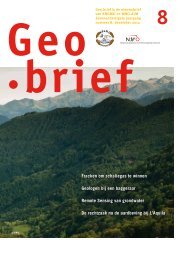You also want an ePaper? Increase the reach of your titles
YUMPU automatically turns print PDFs into web optimized ePapers that Google loves.
the time. It will be interesting to see, if<br />
the companies acted according to a British<br />
model, and this, of course, opens possibilities<br />
for comparison with co-existing<br />
international companies, of which two<br />
were Dutch.<br />
Prospecting and mining are integral<br />
activities in the exploitation of mineral<br />
resources world-wide. As such, my work<br />
is well placed within the over-arching<br />
LASHIPA project of the Arctic Centre.<br />
This acronym stands for Large-scale<br />
Historic Exploitation of Polar Areas. The<br />
project uses a combination of archival<br />
sources as well as archaeological fieldwork<br />
to assess the exploitation of natural<br />
resources from a bi-polar, international,<br />
comparative perspective. My colleagues<br />
and I have complimentary backgrounds<br />
in history, archaeology, geography, and<br />
geology, which allow us to understand<br />
not only the physical aspects of the polar<br />
environments, but also the complexities<br />
of economic, political, and social determinants.<br />
In short, LASHIPA is an ambitious<br />
project.<br />
Exceptional preservation<br />
To date, I have completed two field seasons<br />
on Spitsbergen. My colleagues and<br />
I mostly travel by boat to the fjords that<br />
harbour sites of interest to us, but occasionally<br />
we hike across the hilly and<br />
barren terrain. This has its challenges,<br />
not least because we carry a large-caliber<br />
gun at all times as protection against<br />
Marble Island. Crane brought to the English marble quarry in 1912.<br />
polar bears. Naturally, we have recorded<br />
known mining settlements first and<br />
are progressively moving towards less<br />
well-known or forgotten sites. A detailed<br />
archaeological record is made by survey<br />
only and typically comprises field notes,<br />
digital photographs, measured drawings<br />
and GPS mapping. Due to the exceptional<br />
preservation of structures and artefacts<br />
above ground, excavation is unnecessary.<br />
Away from the mining settlements, I rely<br />
on my geological knowledge to record<br />
and interpret much smaller prospecting<br />
camps identified from historic sources.<br />
To compare their location to present-day<br />
geological maps is of little use, because<br />
the maps did not exist at that time and<br />
were possibly only made by the men who<br />
worked there. My best option is to visit<br />
a selection of camps, firstly to verify the<br />
written sources and secondly to record<br />
any evidence of prospecting in the area.<br />
The remains of huts and tents are quickly<br />
found, but rudimentary prospecting<br />
remains are unknown to Britain and it<br />
is not always obvious what to look for.<br />
Small man-made pits<br />
On Spitsbergen, mineral prospection is<br />
aided by sparse vegetation, steep slopes<br />
and deep stream beds. However, it may<br />
be hindered by inaccessibility and<br />
moraines. As archaeologists, we commonly<br />
underestimate the size of the geological<br />
landscape and the ground covered by<br />
geologists. Always under time pressure,<br />
we can choose few outcrops to inspect.<br />
Besides coal, I knew that the British had<br />
searched for iron, copper, zinc, and lead,<br />
and an understanding of relevant formation<br />
processes definitely helped me to<br />
recognize possible areas of mineralization<br />
and thereby discover rare prospecting<br />
pits and boreholes. It was a painstaking<br />
search for the proverbial needle in the<br />
haystack, and it was made more difficult<br />
by mistaking weathering for archaeological<br />
features. Archaeologists must therefore<br />
remember to compare their features<br />
to patterns typical for the whole outcrop.<br />
Is it worth chasing after small man-made<br />
pits and holes on a huge archipelago?<br />
I certainly think so. They are part of the<br />
human story in the Arctic. It is all too easy<br />
to forget about the prospecting aspect in<br />
light of the more impressive mining settlements,<br />
yet the British companies were<br />
prospecting as well as mining companies.<br />
Their successes must be judged not only in<br />
the coal and ore extracted, but also in the<br />
minerals discovered and claimed, which<br />
were meant to be mined by subsidiary<br />
companies. How successful the companies<br />
were, will be discussed in my doctoral thesis,<br />
which is forthcoming in June 2012.<br />
Frigga Kruse, M.Sc.<br />
Arctic Centre, University of Groningen<br />
f.kruse@rug.nl<br />
Het Lashipa project wordt gefinancierd vanuit het NWO onderzoeksprogramma<br />
dat hoort bij het International Polar Year (IPY).<br />
december 2010 Geo.brief 9



